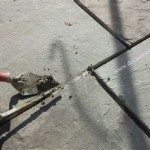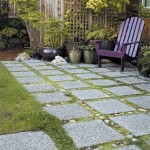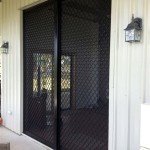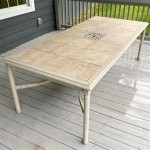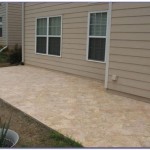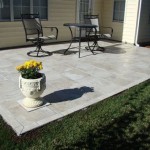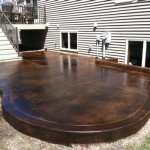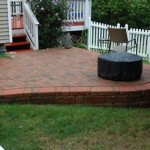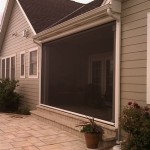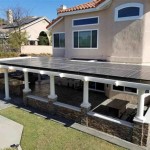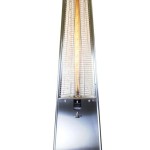```html
How to Clean a Dirty Concrete Patio
A concrete patio can significantly enhance outdoor living space, providing an area for relaxation, entertainment, and dining. However, concrete is porous and susceptible to accumulating dirt, grime, algae, mold, and stains over time. Regular cleaning is essential to maintain the patio's appearance, prevent deterioration, and ensure a safe and enjoyable outdoor environment. This article provides a comprehensive guide to effectively cleaning a dirty concrete patio, covering preparation, different cleaning methods, and preventative measures.
Preparation is Key
Before commencing the cleaning process, meticulous preparation is crucial to maximize effectiveness and minimize potential damage. This involves gathering the necessary tools and materials, protecting surrounding areas, and assessing the severity of the dirt and stains present.
Firstly, assemble the required cleaning equipment. This typically includes a stiff-bristled brush (push broom or scrub brush), a garden hose with a spray nozzle, a bucket, appropriate cleaning solutions (depending on the type and severity of dirt), safety glasses, and gloves. A pressure washer can be a valuable tool for more intense cleaning, but it should be used with caution to avoid damaging the concrete surface. A long-handled squeegee can also be useful for removing excess water after cleaning.
Secondly, protect any nearby plants, furniture, or other outdoor items that could be affected by the cleaning process. Cover plants with plastic sheeting or tarps to shield them from cleaning solutions. Move furniture and other movable objects away from the patio to allow for unobstructed cleaning. Ensure that pets and children are kept away from the area during the cleaning process to prevent accidents.
Thirdly, perform a thorough inspection of the patio to identify the types of dirt and stains present. This will help determine the most appropriate cleaning method and cleaning solutions to use. Common patio stains include dirt, grime, algae, mold, mildew, oil, grease, rust, and organic matter (leaves, bird droppings). Note the location and severity of each type of stain to prioritize cleaning efforts.
Finally, clear the patio of any loose debris, such as leaves, twigs, and dirt. Use a broom or leaf blower to remove this surface layer of dirt and debris. This ensures that the cleaning solutions will directly target the embedded stains and dirt, rather than being absorbed by loose debris.
Cleaning Methods for Concrete Patios
Several cleaning methods can be employed to clean a dirty concrete patio, ranging from simple rinsing to more intensive chemical treatments. The appropriate method will depend on the type and severity of dirt and stains, as well as the available tools and equipment. It is always advisable to start with the gentlest method and progressively increase the intensity as needed.
Rinsing with Water: For patios with light dirt and debris, a simple rinse with water may be sufficient. Use a garden hose with a spray nozzle to thoroughly wet the patio surface. Then, use a stiff-bristled brush to scrub the concrete and dislodge any remaining dirt. Rinse the patio again with water to remove the loosened dirt and debris. This method is effective for routine maintenance and preventing the buildup of light dirt and grime.
Soap and Water: For patios with more stubborn dirt and grime, a solution of soap and water can be used. Mix a mild detergent (such as dish soap or laundry detergent) with warm water in a bucket. Apply the soapy water to the patio surface using a mop or brush. Scrub the concrete thoroughly to loosen the dirt and grime. Rinse the patio well with clean water to remove all traces of soap. Avoid using harsh or abrasive cleaners, as they can damage the concrete surface.
Pressure Washing: Pressure washing is an effective method for removing deeply ingrained dirt, stains, and algae from concrete patios. However, it is crucial to use caution to avoid damaging the concrete. Use a pressure washer with a wide-angle nozzle and set the pressure to a moderate level (around 1500-2000 PSI). Hold the nozzle at a distance of at least 12 inches from the concrete surface and move it in a sweeping motion to avoid concentrating the pressure on any one spot. Overly aggressive pressure washing can etch or damage the concrete surface. Always test a small, inconspicuous area first to assess the effect of the pressure washer on the concrete.
Using Natural Cleaning Solutions: For those seeking environmentally friendly cleaning options, several natural solutions can be effective. A mixture of vinegar and water (equal parts) can help to remove mild stains and algae. Baking soda can be used to scrub away stubborn stains and deodorize the concrete. For mold and mildew, a solution of tea tree oil and water (a few drops of tea tree oil per cup of water) can be applied and left to sit for a few minutes before scrubbing and rinsing. These natural solutions are less harsh than chemical cleaners and are safer for the environment and for people and pets who may come into contact with the patio.
Chemical Cleaning Solutions: In cases of severe staining or stubborn algae and mold growth, chemical cleaning solutions may be necessary. Several commercial concrete cleaners are available, specifically formulated to remove various types of stains. These cleaners typically contain chemicals such as trisodium phosphate (TSP), bleach, or muriatic acid. Always read and follow the manufacturer's instructions carefully when using chemical cleaners. Wear appropriate protective gear, including safety glasses, gloves, and a respirator, to avoid contact with the chemicals. Test the cleaner on a small, inconspicuous area first to ensure that it does not damage the concrete.
For oil and grease stains, degreasers specifically designed for concrete are effective. Apply the degreaser to the stain and let it sit for the recommended time. Scrub the area with a stiff-bristled brush and rinse thoroughly with water. For rust stains, a rust remover formulated for concrete can be used. Follow the manufacturer's instructions carefully and test the cleaner on a small area first. For mold and mildew, a bleach solution (1 part bleach to 10 parts water) can be applied to the affected area. Let it sit for a few minutes, then scrub and rinse thoroughly. Be careful when using bleach, as it can discolor concrete and damage surrounding plants.
Addressing Specific Stains
Different types of stains require different cleaning approaches. Addressing specific stains effectively requires identifying the source of the stain and using appropriate cleaning agents and techniques.
Oil and Grease Stains: Oil and grease stains are common on patios used for grilling or parking vehicles. The first step is to absorb any excess oil or grease with absorbent materials such as kitty litter, sawdust, or paper towels. Apply the absorbent material to the stain and let it sit for several hours or overnight. Then, sweep up the absorbent material and dispose of it properly. Next, apply a concrete degreaser to the stain and let it sit for the recommended time. Scrub the area with a stiff-bristled brush and rinse thoroughly with water. For stubborn stains, a poultice may be necessary. A poultice is a paste made from absorbent materials (such as baking soda or diatomaceous earth) mixed with a solvent (such as acetone or mineral spirits). Apply the poultice to the stain and cover it with plastic wrap. Let the poultice dry completely, then scrape it off and rinse the area with water.
Algae and Mold Stains: Algae and mold thrive in damp, shady areas and can cause concrete to become slippery and discolored. To remove algae and mold, first, scrub the affected area with a stiff-bristled brush to remove any loose growth. Then, apply a solution of bleach and water (1 part bleach to 10 parts water) to the area. Let it sit for a few minutes, then scrub and rinse thoroughly. Alternatively, a commercial mold and mildew remover can be used. Follow the manufacturer's instructions carefully and test the cleaner on a small area first. To prevent the recurrence of algae and mold, ensure that the patio is well-drained and receives adequate sunlight. Prune any overhanging trees or shrubs that are creating excessive shade.
Rust Stains: Rust stains can be caused by metal objects left on the patio or by rusty nails or screws in the concrete. To remove rust stains, use a rust remover specifically formulated for concrete. Apply the remover to the stain and let it sit for the recommended time. Scrub the area with a stiff-bristled brush and rinse thoroughly with water. For stubborn stains, repeat the process or use a rust stain remover containing oxalic acid. Follow the manufacturer's instructions carefully and test the cleaner on a small area first.
Organic Stains (Leaves, Bird Droppings): Organic stains can be caused by fallen leaves, bird droppings, and other organic matter. To remove these stains, first, remove any loose debris from the patio. Then, scrub the area with a solution of soap and water or a mild detergent. For stubborn stains, a mixture of baking soda and water can be used. Apply the paste to the stain and let it sit for a few minutes, then scrub and rinse thoroughly. For bird droppings, wear gloves and a mask when cleaning, as they can contain harmful bacteria.
After addressing specific stains, a final overall cleaning of the patio with soap and water or a pressure washer will ensure a uniform and clean appearance.
```
How To Clean Concrete The Easy Way Porches Patios Driveways More Run Radiance

Best Way To Clean A Concrete Patio Chalking Up Success

The Easiest Way To Clean A Concrete Patio My Creative Days

Diy Miracle Concrete Patio Cleaner I Should Be Mopping The Floor

6 Easy Ways To Clean Your Concrete Patio For Spring

Diy Miracle Concrete Patio Cleaner I Should Be Mopping The Floor

Diy Miracle Concrete Patio Cleaner I Should Be Mopping The Floor

How To Clean A Concrete Patio Remove Tough Stains

How To Clean Concrete The Easy Way Porches Patios Driveways More Run Radiance

The Easiest Way To Clean A Concrete Patio My Creative Days
Related Posts


